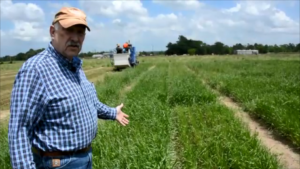Overton: Test plots and online database offer winter pasture information to producers
- Writer: Adam Russell, 903-834-6191, [email protected]
- Contact: Dr. Gerald Smith, 903-834-6191, [email protected]
OVERTON – Annual ryegrass and small-grain test plots and online historical trial results provide solid winter pasture information for East Texas producers, said a Texas A&M researcher.

Annual ryegrass cultivars and small grain cultivars are evaluated each year at Overton for cold tolerance, disease incidence and seasonal forage yield, said Dr. Gerald Smith, Texas A&M AgriLife Research legume and grass breeder, Overton. The trials are conducted in replicated, randomized complete-block designs using fertilizer and lime recommendations based on annual soil tests.
Smith said the forage trials are conducted to help regional producers choose the best cultivars for their operations and to help seed companies evaluate experimental lines. Each year of forage production data for dozens of varieties is collected and compiled in the Ryegrass and Small Grains Evaluation page – http://bit.ly/2oLztKx – on the Texas A&M AgriLife Research and Extension Center, Overton website.
“Ryegrass is a very important winter pasture option here and across the Southeast U.S.,” he said.
Smith said about 50 ryegrass varieties are being tested this year, including experimental varieties. Plots are typically planted in September and harvested through spring.
Ryegrass plots are harvested around every three to four weeks and yields are posted online on the Overton website, Smith said. The website includes information on Overton ryegrass variety trials from the last 10 years. Varieties tested include Winterhawk, Gulf, Diamond T and the Texas A&M varieties TAM 90, Nelson and TAMTBO.
The database also includes information including nitrogen applications and date planted.
Most varieties in the database have been tested multiple years, Smith said. Three-year average yields are available for many varieties so producers can gauge how they performed in various seasonal conditions.
“One year of data isn’t indicative of how a variety might perform,” he said. “We try to give people a chance to look at how a variety might perform three years in a row because each year’s data is very dependent upon weather conditions.”
The Overton website has yield information going back more than a decade for some varieties, Smith said.
“A producer can go to the historical evaluations all the way back to 2003 for some varieties,” he said. “The whole purpose of the evaluations and compiling the data is to give producers the information so when they go to the seed store they have a good idea what might work best for them. It might make them aware of a variety that may be better than the variety they’ve always planted.”


